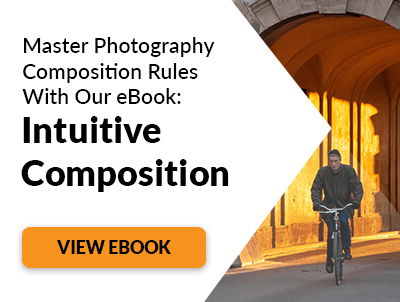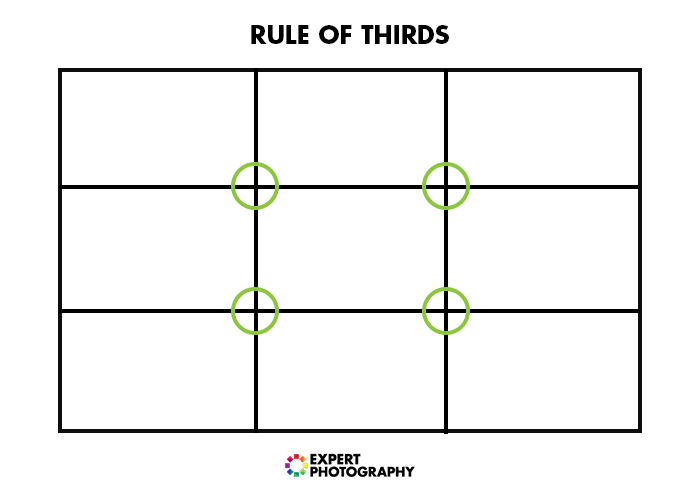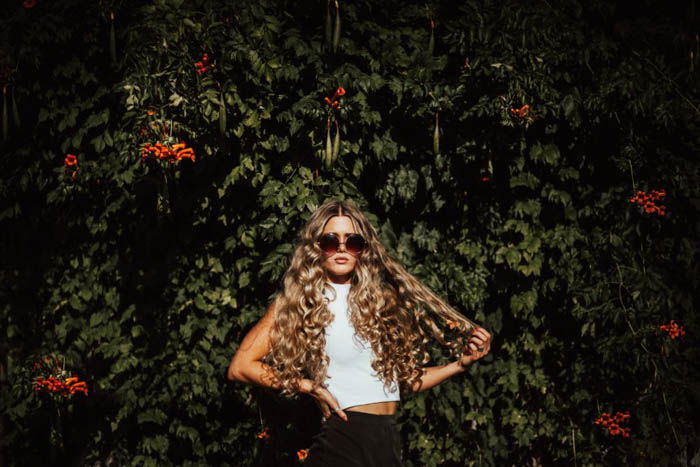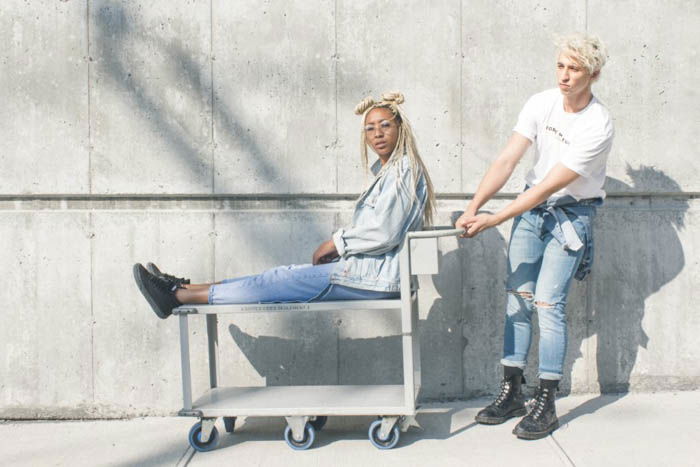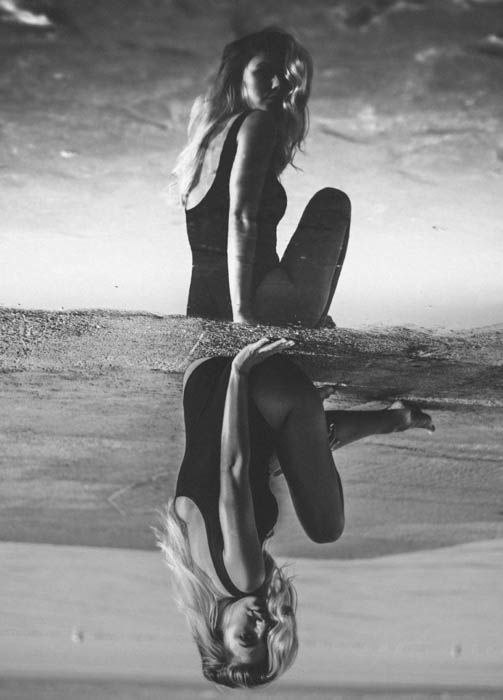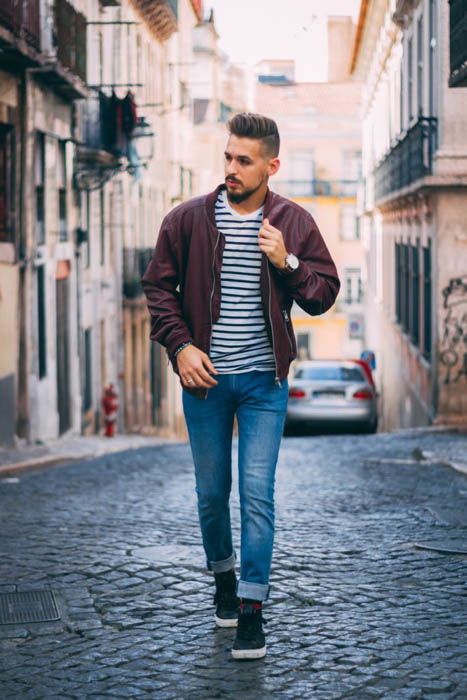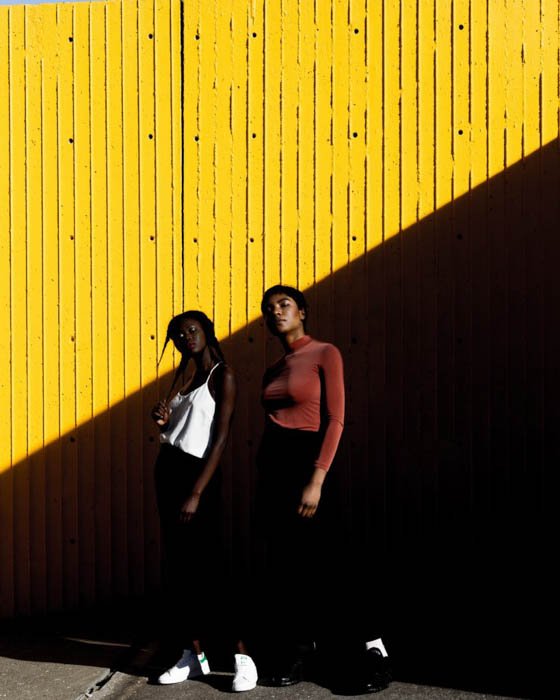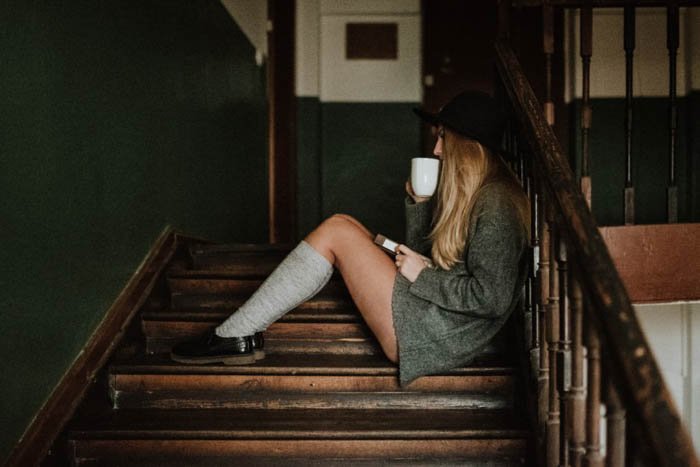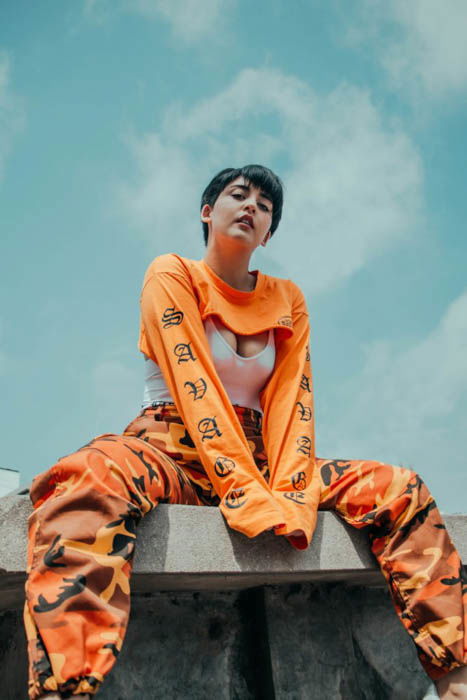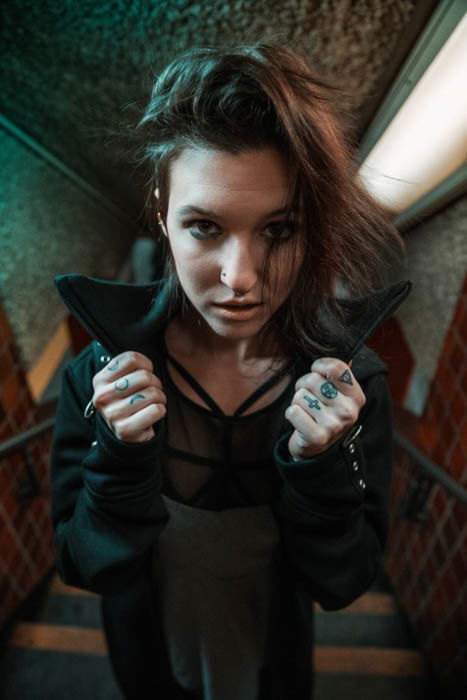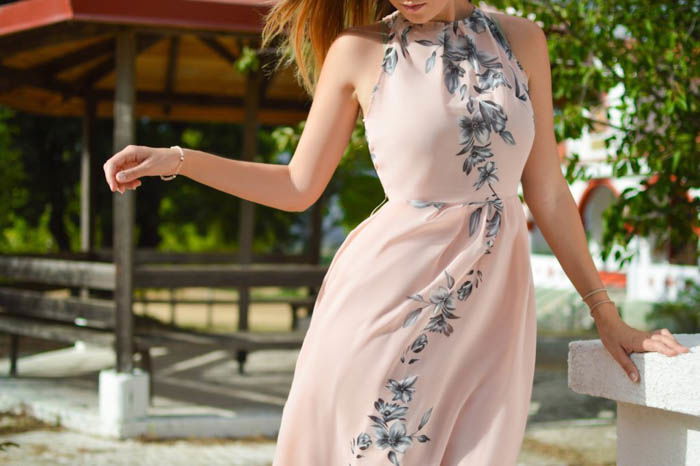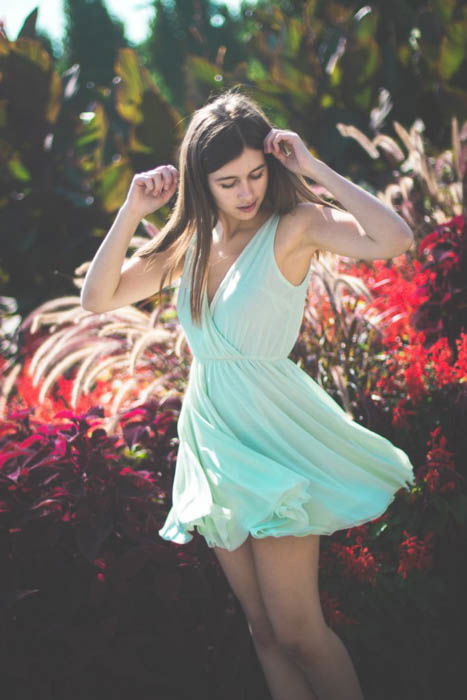Showcasing what they’re wearing at the same time may require some serious composition skills. Thankfully, we have some useful tips to help you take well-composed magazine-worthy shots. So, let’s start!
10. Learn the Rule of Thirds in Fashion Photography
The rule of thirds is a crucial guideline in making sure your composition is on point. So how do you apply it? First mentally divide your frame into nine squares of equal sizes–much like a tic-tac-toe grid. To achieve a balanced composition, put your subject in any of the points where the lines intersect. You can also use your camera for help. Almost every camera nowadays has a grid-line function to assist you in composing your shots. Once you activate it on your device, simply move your camera until your subject is in one of the intersections on the screen. The rule of thirds is useful especially if you’re not sure where to place your model. As long as you stick to it, your composition will improve significantly. After a while, you won’t even need to turn on the grid-lines in your camera, it’ll be instinctual.
9. Place Your Subject in the Center
Every once in a while, you can break photography composition rules to get the shot you want. Sometimes, you can even ignore the rule of thirds completely and put your subject right in the center. If you do it correctly, you’ll realise that this style works perfectly for fashion portraits. Since your main point of interest is already in the middle, the viewer will see it immediately. However, just remember that placing your subject in the center can sometimes make the image look static and uninteresting. Therefore, you need to keep in mind a few tips to make this unusual composition work. The primary factor to consider is the background. Look for a location that has something you can use to balance your composition. For instance, the photo below uses the flowers surrounding the model to frame her. The triangle formed by her hair and arms also add balance to the image. Next, you’ll need to think of appropriate poses to prevent your photo from looking too rigid. Ask your model to move around, flip their hair, or swing their arms outwards. Look for ways to make them look graceful. Additionally, you can have the model lean slightly to the side to make them look less stiff. Asking them to look either left or right would make people think something is going on off-camera. Consequently, all the negative space around your subject is now providing curiosity to the viewer.
8. Create a Counterbalance
As you can tell by now, the secret to composition is achieving balance. However, sometimes you’re forced to place your subjects in unusual places. If this happens, you can use a counterbalance to correct your composition. Counterbalance involves using another component in the frame to create harmony in your image. If the woman sitting on the cart below was by herself, the composition would look lopsided because she’s in the center. Adding another model to push her from behind leads to balance. The photo below is another great example. The reflection adds visual interest to what would otherwise be dead space. The double image also creates symmetry.
7. Tell a Story
One of the mistakes that budding fashion photographers often make is not including a visual narrative in their shoot. When you browse through a fashion magazine, you’ll notice that there’s a theme that connects the photos. Although they don’t necessarily have words describing what’s happening, they often provide clues about what’s going on. These types of images grab attention. They force the viewer to focus on the narrative they’re trying to tell. Including a cohesive concept in your pictures will compel people to look at every image you show them. Your theme doesn’t necessarily have to have a real story with a beginning and an end. Since you can’t rely on captions, you need to rely on your composition and focus on the small moments. For instance, when you’re shooting a model exploring the city, you can have them walk around the streets or visit a cafe. Use the elements in the surroundings to provide hints. For instance, placing someone close to the camera with the road in the background will make your viewer curious about where the subject is going. When you frame your scene, remember that sometimes leaving out specific components in the photograph encourages imagination.
6. Look For The Appropriate Background
Always be mindful of the background while shooting because it plays an essential role in your composition. Don’t just think about where to place the model. Consider how the elements in the background would affect the balance of your image. Your composition style should adapt to the garment you’re photographing. You can’t use a background that’s similar to the color or the pattern of the clothes. If an outfit has complicated patterns, then look for a background that’s neutral. If it’s plain, feel free to look for an elaborate backdrop that compliments it. Your backdrop should also lead the viewer’s eyes to the subject. People naturally follow lines and curves. If a background (or foreground) has those features, you can use them to direct attention to your model. Thankfully, you’ll find plenty of them in urban environments such as streets, rails, and staircases. Similarly, you can use squares and rectangles to frame your model. When you put your subject in a “box,” people will naturally be drawn to it. Remember to pay attention to the buildings, trees, and even light poles that may be behind your model. You wouldn’t want them to appear like they’re sticking out of your subject’s head.
5. Bring Props
Props are helpful in creating a more coherent theme in your fashion photography. They not only work well in providing the context clues to your images but also add dimension to your composition. If there’s nothing much going on in your scene, you can also use props to make it look more interesting. For instance, if the wall you chose as a background looks too bland, just add a skateboard and voila! The arms and the skateboard form a natural frame around the model’s face. With all the negative space around, it helps show the viewer where they should look. You can even create surrealistic scenes by arranging unusual things around your subject. The photo below wouldn’t have been as interesting if it wasn’t for the oranges that surround the model. The oranges direct the viewer’s eyes to the center where the model is. You can arrange objects like lines, curves, or shapes to bring focus to the main point of interest.
4. Interact With The Environment
To make your image more dynamic, don’t just let your model stand around. Have them play around the space they’re in. It doesn’t only make posing more comfortable for them, but interacting with the environment can also create an interesting composition. For example, if you’re doing a shoot in the streets, you can ask your model to get inside a car. Although shooting in vehicles can be challenging, you can use car windows, doors, and even mirrors to frame your subject. You can also look for manmade structures at your location and use them to pose your model. Ask your subject to sit on stairs or lean against a handrail. Doing so will make them feel more relaxed and less posy. What’s also great about these artificial platforms is that they often have leading lines that guide the viewer where to look. The image below uses the handrail and the stairs to point to where your eyes should be going.
3. Try Different Angles
When you’re shooting, don’t restrict yourself to eye-level angles. Explore your environment and consider the different places from which you can photograph your model. You can take pictures from above, below, or even by tilting your camera slightly. However, before experimenting with perspective, remember that changing it can radically alter the mood of a photograph. Consider the particular feeling you want to convey in your image. Then, find a way to show that in your work through careful framing. Keep in mind that each angle has pros and cons, so think about their effect on your audience. If you want your model to dominate your shot, then shoot from a low angle. It doesn’t only make them look big, but it also emphasizes the outfit they’re wearing. However, be careful not to get too close because they’d appear menacing otherwise. For an intimate look, you can try shooting from a high angle. Since your camera is closer to your model’s eyes, it creates a more emotional connection. If you take pictures higher up, it can even evoke the feeling of freedom. However, this angle can also make your subject look small and inferior, so use it only when it works for the mood you’re after. If you want your image to look edgy, then try unusual perspectives such as the Dutch tilt. This technique involves tilting the camera diagonally. The resulting image evokes danger and precariousness. The gritty look it creates makes it perfect for shooting in urban environments. On the other hand, its imbalance can also make people feel anxious and uncomfortable.
2. Highlight the Fashion
What separates fashion photographers from regular portrait photographers is that they know how to emphasise the clothes in their images. So no matter what you do, always prioritise how you want to present the outfit. When you pose your subject, make sure not to obstruct the details of the outfit. It’s your job to make sure the viewers see the selling point of the product. Avoid any prop that could distract the eyes, and get close enough to show any patterns.
1. Let the Outfit Flow
Since pictures are static, it can sometimes be difficult to show the texture of the garment. Without movement, an outfit could end up looking stiff even if it isn’t. As a fashion photographer, it’s your task to convey the smoothness of whatever your model is wearing. The secret is creating movement whenever possible. Have your subject run around and spin. Let the fabric flow in the air and freeze the motion with your camera. When the skirt or the dress is floating in the air, it often forms a triangle, which in turn creates a balanced composition. Since the shape also points upwards, it naturally directs the eyes to the model as well. Additionally, you can use long and flowy dresses to fill negative spaces. If there’s nothing much happening on one side of your frame, just let the dress flow that way and you’ll achieve balance. However, not every outfit floats effortlessly in the air. If it hugs your model tightly, you can use their body form to evoke movement, instead. Let them pose in a way that accentuates their curves. The s-shape their body creates should make the fabric appear soft and flowy.
Conclusion
You can easily apply many of the skills you already know as a photographer when you start shooting fashion. However, you also might miss a few things if you don’t change your approach according to the needs of the genre. Learn to adapt to the situation, and keep in mind that the outfit is always the star of the show. As long as you remember these fashion photography tips every time you shoot, you’ll see your images look better and better every time. Check out our smartphone fashion photography or creative self-portrait tips for more cool ideas!

